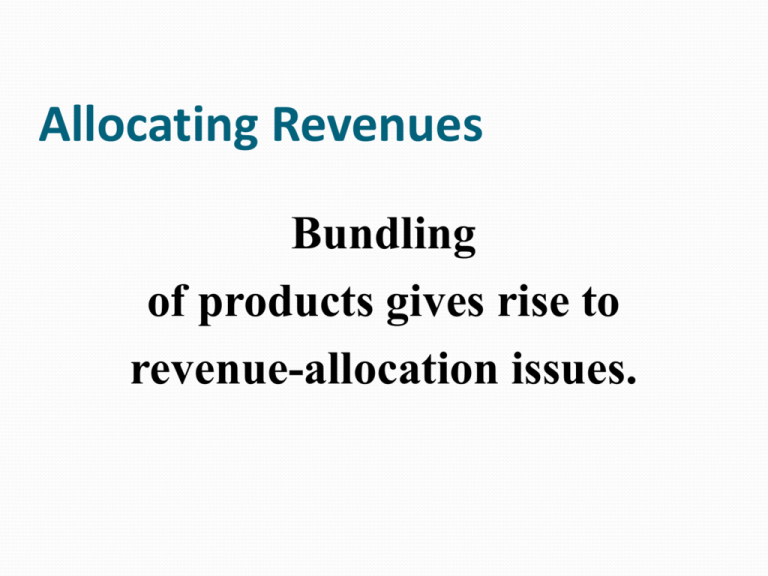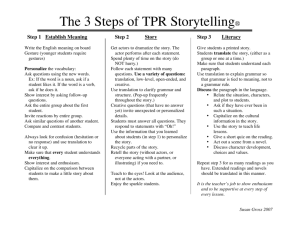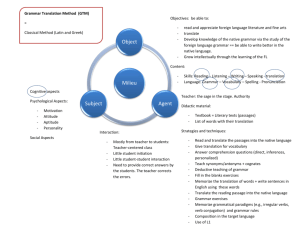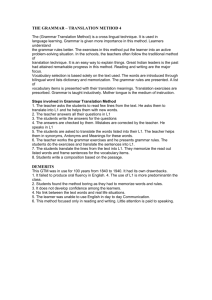Revenue allocation, bundled products
advertisement

Allocating Revenues Bundling of products gives rise to revenue-allocation issues. Revenues and Bundled Products A bundled product is a package of two or more products (or services) sold for a single price. Bundled product sales are also referred to as “suite sales.” The individual components of the bundle also may be sold as separate items at their own “stand-alone” prices. Revenues and Bundled Products What businesses provide bundled products? Banks Checking Safety deposit boxes Investment advisory Hotels Lodging Food and beverage services Recreation Tours Transportation Lodging Guides Revenue Allocation Methods English Languages Institute buys English language software programs and then sells them in Mexico and Central America. English sells the following programs: Grammar, Translation, and Composition These programs are offered stand-alone or in a bundle. Revenue Allocation Methods Stand-alone Grammar Translation Composition Price $255 $ 85 $185 Purchasing these software programs costs English the following: Grammar $180 Translation $ 45 Composition $ 95 Revenue Allocation Methods Bundle (Suites) Grammar + Translation Grammar + Composition Grammar + Translation + Composition Price $290 $350 $410 Revenue Allocation Methods The two main revenue allocation methods are: 1. The stand-alone method 2. The incremental method Stand-Alone Revenue Allocation Method There are four types of weights for the stand-alone revenue allocation method. 1. Selling prices 2. Unit costs 3. Physical units 4. Stand-alone product revenues Stand-Alone Revenue Allocation Method Consider the Grammar and Translation suite, which sells for $290. How much weight should English Languages Institute assign to each item? Stand-Alone Revenue Allocation Method Selling prices: The individual selling prices are $255 for Grammar and $85 for Translation. $255+85 = $340 total, so… Grammar: $255 ÷ $340 = 0.75, $290 bundle SP × 0.75 = $217.50 Translation: $85 ÷ $340 = 0.25, $290 × 0.25 = $72.50 Stand-Alone Revenue Allocation Method Unit costs: This method uses the costs of the individual products to determine the weights for the revenue allocations. Grammar: $180 ÷ $225 = 0.80, $290 × 0.80 = $232 Translation: $45 ÷ $225 = 0.20, $290 × 0.20 = $58 Stand-Alone Revenue Allocation Method Physical units: This method gives each product unit in the suite the same weight when allocating suite revenue to individual products. With two products in the suite, each product is allocated 50% of suite revenues. 1 ÷ (1 + 1) = 0.50 $290 × 0.50 = $145 Stand-Alone Revenue Allocation Method Stand-alone product revenues: This method captures the quantity of each product sold as well as their selling prices. Assume that the stand-alone revenues in 2003 are Grammar $734,400, Translation $81,600, and Composition $133,200. What are the weights for the Grammar and Translation suite? Stand-Alone Revenue Allocation Method Grammar: $734,400 ÷ $816,000 = 0.90, $290 × 0.90 = $261 Translation: $81,600 ÷ $816,000 = 0.10, $290 × 0.10 = $29 Stand-Alone Revenue Allocation Method Revenue Allocation Weights Grammar Translation Selling prices $217.50 $ 72.50 Unit costs 232.00 58.00 Physical units 145.00 145.00 Stand-alone product revenues 261.00 29.00 Incremental Revenue Allocation Method The first-ranked product is termed the primary product in the bundle. The second-ranked product is termed the first incremental product. The third-ranked product is the second incremental product, and so on. Incremental Revenue Allocation Method Assume that Grammar is designated as the primary product. If the suite selling price exceeds the standalone price of the primary product, the primary product is allocated 100% of its stand-alone revenue. Incremental Revenue Allocation Method Grammar and Translation suite selling price = $290 per day Allocated to Grammar: $255 Remaining to be allocated: ($290 – $255) = $35 Allocated to Translation: $35









